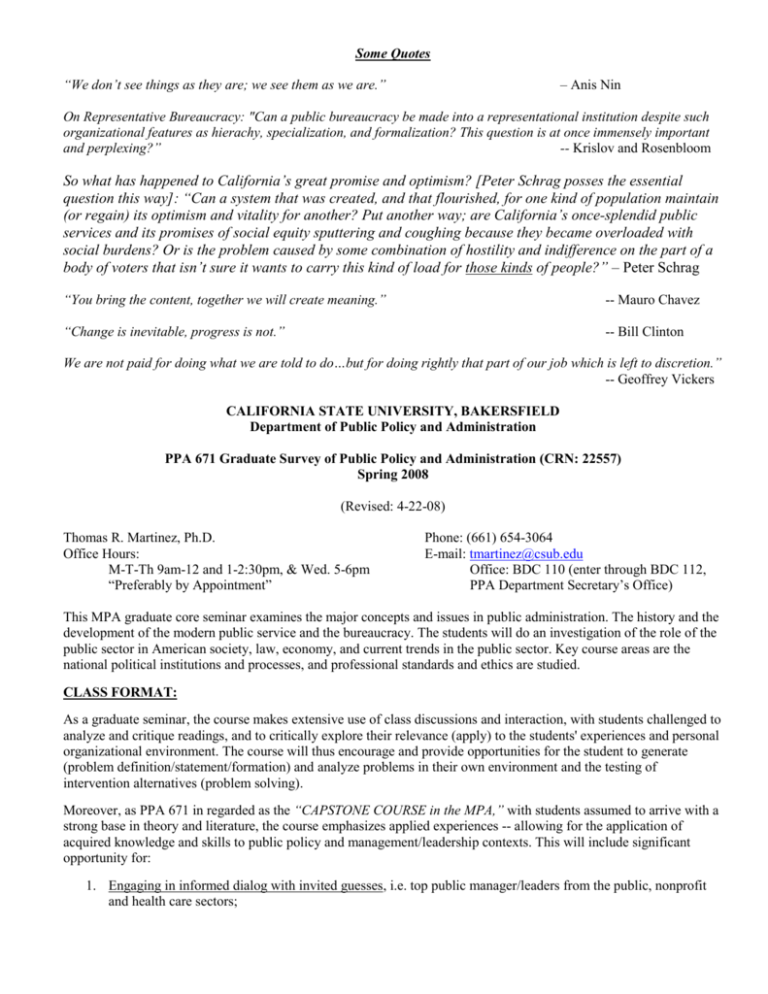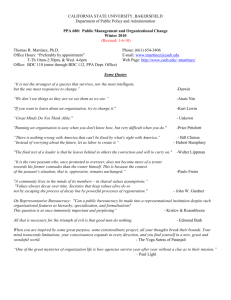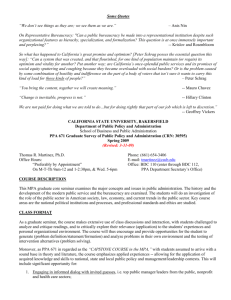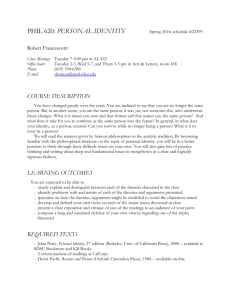Part I: EARLY VOICES AND THE FIRST QUARTER CENTURY
advertisement

Some Quotes “We don’t see things as they are; we see them as we are.” – Anis Nin On Representative Bureaucracy: "Can a public bureaucracy be made into a representational institution despite such organizational features as hierachy, specialization, and formalization? This question is at once immensely important and perplexing?” -- Krislov and Rosenbloom So what has happened to California’s great promise and optimism? [Peter Schrag posses the essential question this way]: “Can a system that was created, and that flourished, for one kind of population maintain (or regain) its optimism and vitality for another? Put another way; are California’s once-splendid public services and its promises of social equity sputtering and coughing because they became overloaded with social burdens? Or is the problem caused by some combination of hostility and indifference on the part of a body of voters that isn’t sure it wants to carry this kind of load for those kinds of people?” – Peter Schrag “You bring the content, together we will create meaning.” -- Mauro Chavez “Change is inevitable, progress is not.” -- Bill Clinton We are not paid for doing what we are told to do…but for doing rightly that part of our job which is left to discretion.” -- Geoffrey Vickers CALIFORNIA STATE UNIVERSITY, BAKERSFIELD Department of Public Policy and Administration PPA 671 Graduate Survey of Public Policy and Administration (CRN: 22557) Spring 2008 (Revised: 4-22-08) Thomas R. Martinez, Ph.D. Office Hours: M-T-Th 9am-12 and 1-2:30pm, & Wed. 5-6pm “Preferably by Appointment” Phone: (661) 654-3064 E-mail: tmartinez@csub.edu Office: BDC 110 (enter through BDC 112, PPA Department Secretary’s Office) This MPA graduate core seminar examines the major concepts and issues in public administration. The history and the development of the modern public service and the bureaucracy. The students will do an investigation of the role of the public sector in American society, law, economy, and current trends in the public sector. Key course areas are the national political institutions and processes, and professional standards and ethics are studied. CLASS FORMAT: As a graduate seminar, the course makes extensive use of class discussions and interaction, with students challenged to analyze and critique readings, and to critically explore their relevance (apply) to the students' experiences and personal organizational environment. The course will thus encourage and provide opportunities for the student to generate (problem definition/statement/formation) and analyze problems in their own environment and the testing of intervention alternatives (problem solving). Moreover, as PPA 671 in regarded as the “CAPSTONE COURSE in the MPA,” with students assumed to arrive with a strong base in theory and literature, the course emphasizes applied experiences -- allowing for the application of acquired knowledge and skills to public policy and management/leadership contexts. This will include significant opportunity for: 1. Engaging in informed dialog with invited guesses, i.e. top public manager/leaders from the public, nonprofit and health care sectors; 2. Utilizing current sources of applied research and data based information sources, on substantive issues in governmental policy, management, finance and public service, placing in the context their political, economic, legal and social environments; and, 3. Participating in small group/team project activities. The professor shall emphasize an exploratory tone toward the content and a process orientation toward instruction – seeking to create a learning community. “You bring the content, together we will create meaning.”- Mauro Chavez Note: Due to the interactive nature of the course and the heavy reading load, students should have read all assigned readings before class and should be prepared to discuss readings, relate personal critique and experiences, and/or to raise critical questions. MEANINGFUL CLASS PARTICIPATION if required. Due to the interactive nature of the course, students should plan to attend all class sessions as it is assumed that, ATTENDANCE is a prerequisite to meaningful participation. Also, all assignments shall be completed on time. Email: Students are encouraged to check their Runner email account at several times a week for messages from the professor. When sending email to the professor, please begin the Subject-Line with the identifier, “PPA 671.” Then, identify the nature of the Message, e.g. “Question,” “Here is Assignment #X,” etc.” COURSE ASSIGNMENTS ASSIGNMENT #1 - ANALYSIS, APPLICATION & CRITIQUE: Based on one assigned reading, or a set of assigned readings from a single author, present a focused "Analysis" of key concepts and essential organizing principles proposed in the reading, then briefly discuss its "Application" to your organization setting/experience (e.g. denotative definition). Also, provide Critique comments, discussing the value of the reading. Be prepared to discuss in class. (This should usually not exceed 2 single-spaced pages.) 10 pts For example: On Analysis of the single reading, the student seeking to be faithful to the author’s stated or inferred intent might answer questions such as: 1. What are minimum Essential Elements (EE) that define concept(s) or value(s) proposed by the author? 2. What Essential Organizing Principles (EOP) are proposed (i.e. “That X in a means for Y”)? 3. What Essential Analytical Question(s) (EAQ) are posed (i.e. “What is the relationship of X to Y?”)? On the Application piece, the student should offer a brief, but clear, example from their real world experience which illustrates the above. On the Critique piece, the student, seeking to assist the class in assessing the value and/or significance of the reading, should briefly evaluate the reading, e.g. What does the reading add to our understanding? How does the reading clarify or articulate a critical concept or value? Or, why is it a significant? In all cases, be sure to provide a full and proper citation for the article selected. ASSIGNMENT #2a and #2b - TEAM PRESENTATIONS: (i.e. 2 @ 15 pts. ea. = 30pts.) Students shall “twice” form into small teams of 3 to investigate a substantive public policy area or public management issue impacting state, national of local government, nonprofit or health care management sectors. (These should usually not exceed 2-3 single-spaced pages each.) 30 pts Each student team shall select and examine a substantive public policy areas or public management issues which may include: Education/Human Capital Environment/Quality of Life Health/ Public Health/Health Care Demographic/Population/Immigratio n /Aging Crime/Law/Justice Transportation/Urban Planning/Housing Public Finance/Economic Development/Jobs Social Policy/Housing/Employment Civic Engagement/Social Capital Ethics/Social Equity/Responsibility/ & Efficiency InformationManagement/Technology Merit & Representative Bureaucracies Each team shall meet and organize themselves to investigate the public policy or management issue drawing on a “variety” of current sources of policy/management research and/or data based supporting information, e.g. exploring 1) substantive “public policy research centers and institutes; 2) discipline based academic journal articles or texts; and/or, 3) demographic/public policy data sources. (NOTE: A partial list of annotated Public Policy Research Centers & Institutes; and, a partial list of links to Demographic Public Policy Data Sources are available on the professor’s faculty web page.) Class time will be allowed for teams to meet and begin planning an “integrated” team presentation. While each student will be responsible for a presenting a separate source(s) and separate paper, however, working together the team should seek to present a well rounded and mutually informed presentation. Each team will be responsible for a “formal” group present of approximately 20-30 minutes, followed by in-class Q & A. We will plan for 2-3 Team Presentations per session beginning week 3. The teams should have met and decided on their individual contribution, and should ONE WEEK IN ADVANCE be in position to inform the class of the specific readings, articles, studies, etc. to be utilized. If the source(s) is available on-line, the team should provide the class with the internet address(s). In all cases, be sure to provide a full and proper citation for the article(s) / source(s) selected. ASSIGNMENT #3: WEEKLY QUICK NEWS REVIEW OF GOVERNMEN POLICY & POLITICS (1 @ 1 single-spaced pg.) Each student will be responsible for a review of an informative short article, research report, or column that on a “specific” and critical public policy matter, along with a brief analysis and explanation of the “general” public policy and/or administrative principles and challenges inferred. The students should be prepared for a brief 3-5 minute in-class discussion/presentation. 5pts For example, the student may draw on sources from a Public Policy Research Center or Institute, or, from a California State Government & Politics Columnists such as: Dan Walters, Sacramento Bee http://www.sacbee.com/walters/ Peter Schrag, Sacramento Bee http://www.sacbee.com/344 In all cases, be sure to provide a full and proper citation for the article selected. ASSIGNMENT #4, FINAL PAPER: Applied Research, Policy Analysis/Program Evaluation, or, a Program Proposal/Project Plan (i.e. 8-10 pages double-spaced). This shall include an INTRODUCTION with a focused Statement of the Problem, Purpose of the Study and Importance of the Study, as in PPA 698 Mater Papers. This shall include a properly site academic/professional Review of Literature which is used to “inform” the write and reader on the problem and potential solution strategies -- Also, a 1-page, single spaced, Executive Summary, Abstract, or Transmittal Memo. Prepare a focused 5-10 minute formal class presentation. 20 pts MEANINGFUL CLASS PARTICIPATION: (including attendance, quality of engagement in /contribution to in-class exercises and discussion) Due to the participative nature of the course, it is imperative that all assignments be completed on time. Also, as it is assumed that, “ATTENDANCE” is a prerequisite to participation. To insure that students not “miss-out” on the course learning, “any student missing a night’s class is expected to, upon return, submit a -page single-spaced ‘MISSED-CLASS ASSIGNMENT’ consisting of an Analysis, Application & Critique of the night’s readings.” Be sure to include “date” of class missed. 20 pts OTHER IN-CLASS WRITTEN EXCERSIZES: (TBA) 5 pts FINAL EXAM : 10pts 100 pts. Total = GRADING: 94 -100% = A 80 - 83% = B90 - 93% = A78 - 79% = C+ 88 - 89% = B+ 74 - 77% = C 84 - 87% = B 70 - 73% = CASSIGNED READINGS (Required): 68 - 69% = D+ 64 - 67% = D 60 - 63% = D0 - 59% = F A short reader for the course has been prepared by the instructor which draws on various books and journal articles use to supplement the course with perspectives on recurring or emerging theoretical issue in the field of public policy and administration (see PPA 671 Reader). The Reader is available for purchase “at cost” of printing. In addition, some key terms used in the field are available on the professor’s web page, click on Public Administration Dictionary. COURSE SCHEDULE: (“Tentative”) WEEK (Date) TOPIC 1 (3- 26) Welcome & Introductions: Course Orientation New Course Design: “…exploratory tone toward the content and a process orientation toward instruction” Assignments: Readings; Individual and Teams; Analysis of the General Field of Public Administration & Management: Parameters of the Field: Parameters, Key Constructs; and, Key Values Three Perspectives on Public Administration & Management: i.e. Management, Politics, and Law Team Projects: Planning Time 2 (4-2) Public Policy Context & Challenges: California Government, Politics & Policy Critical/Recurring Themes in Pub Admin/Pub Mgmt Public Policy Analysis Baldassare, Mark, “California's Future: In Your Hands,” Public Policy Institute of California, October 2006 (Infrastructure). http://www.ppic.org/main/publication.asp?i=715 Peter Schrag, “Reforming California: Many People Have Big Ideas on the Critical Issues Facing The State, But, Are They Thinking Too Small?” Sacramento Bee, September 24, 2006. (Short) http://www.ccsce.com/issues_reformingCA.html Neal Peirce, “State Budget Cuts: Shadow Over Our Future,” Washington Post Writers Group – January 27, 2008. pgs. 2 (Short) http://www.postwritersgroup.com/archives/peir080127.html 3 (4-9) Weekly Quick News Team Projects: Planning Time TEAM PROJECT: PRESENTATION(s) Performance, Perception, Art and Science Mastracci, Sharon H., Meredith A. Newman, and Mary E. Guy, “Appraising Emotion Work: Determining Whether Emotional Labor is Valued in Government Jobs,” American Review of Public Administration (ARPA), Vol. 36, No. 2, June 2006. (Keywords: Emotional Labor/Performance Appraisal/Gender Differences/Wage Disparity) Hummel, Ralph P., “Stories Managers Tell: Why They Are as Valid as Science,” Public Administration Review (PAR), Vol. 51, No. 1, January/February, 1991. A CRITICAL DIALOG WITH: Stephen W. Schilling, Chief Executive Officer, Clinica Sierra Vista http://www.clinicasierravista.org/home.php 4 (4-16) Weekly Quick News Team Projects: Planning Time TEAM PROJECT: PRESENTATION(s) Intergovernmental Management: Opportunities and Challenges Kettl, Donald F., “Managing Boundaries in American Administration: The Collaborative Imperative,” Public Administration Review, Supplement to Vol. 66, December 2006. Lim, Hong-Hai, “Representative Bureaucracy: Rethinking Substantive Effects and Active Representation,” Public Administration Review, Vol. 66, No. 2, March/April 2006. A CRITICAL DIALOG WITH: Ronald E. Brummett, Executive Director, Kern Council of Governments (Kern COG) (Transportation & Planning; Inter-governmental Mgmt) http://www.kerncog.org/ 5 (4-23) Weekly Quick News Team Projects: Planning Time TEAM PROJECT: PRESENTATION(s) California’s Policy & Political Context: The Frustration of Governance & Management Schrag, Peter, Paradise Lost: California’s Experience, America’s Future , The New York Press, 1998. Part I: Introduction “Opportunities and Challenges for the California Economy,” California Economic Growth-2006 Edition, Chapter 2, Center for the Continuing Study of the California Economy. Pgs. 38 http://www.ccsce.com/whatsnew.html A CRITICAL DIALOG WITH: John Nylon, Director of Public Health Services, (formerly, of Kern Child Support; and, ETR) http://www.co.kern.ca.us/health/ 6 (4-30) Weekly Quick News Team Projects: Planning Time TEAM PROJECT: PRESENTATION(s) Politics, Bureaucracy and Ethics Garrett, Sam R., James A. Thurber, A. Lee Fritschler, and David H. Rosenbloom, “Assessing the Impact of Bureaucracy Bashing by Electoral Campaigns,” Public Administration Review, Vol. 66, No. 2, March/April 2006. Zanetti, Lisa A., “Repositioning the Ethical Imperative: Critical Theory, Recht, and Tempered Radicals in Public Service,” American Review of Public Administration (ARPA), Vol. 34, No. 2, June 2004. (Keywords: Critical Theory/Ethics/Theory and Practice/Social Change) A CRITICAL DIALOG WITH: Elena Acosta, Program Director, Kern County Department of Human Services http://www.co.kern.ca.us/dhs/ 7 (5-7) Weekly Quick News Team Projects: Planning Time TEAM PROJECT: PRESENTATION(s) Citizen Participation/Civic Engagement Callahan, Kathe, “Citizen Participation: Questions of Diversity, Equity and Fairness,” Journal of Public Management & Social Policy, Vol. 13, Issue 1, Spring 2007. Brainard, Lori A., “Citizen Organizing In Cyberspace,” American Review of Public Administration (ARPA), Vol. 33, No. 4, December 2003. (Keywords: Organizing/Internet/Civic Engagement/Social Capital/Health Care/E-Government) Ebdon, Carol, and Aimee L. Franklin, “Citizen Participation in Budgeting Theory,” Public Administration Review, Supplement to Vol. 66, No. 3, May/June 2006. A CRITICAL DIALOG WITH: The Honorable Judge Robert Tafoya, Kern Superior Court (Law, Crime, Justice) Final Paper: Instructions Weekly Quick News 8 (5-14) Team Projects: Planning Time TEAM PROJECT: PRESENTATION(s) Public Policy Values and Argument Rosenbloom, David H., “Taking Social Equity Seriously in MPA Education,” Journal of Public Administration Education (JPAE), Vol. 11, No. 3, July 2005, pp. 247-252. (pair of readings) Svara, James H., and James R. Brunet, “Social Equity Is a Pillar of Public Administration,” Journal of Public Administration Education (JPAE), Vol. 11, No. 3, July 2005, pp. 253-258. SELECTED CHAPTERS FROM: Lakoff, George, Thinking Points: Communicating Our American Values and Vision. Rockridge Institute, 2006. Available on-line at: http://www.rockridgeinstitute.org/thinkingpoints 9 (5-21) Weekly Quick News Final Paper Proposals: Due electronically before class-time Nonprofit Management Slyke, Van M. and Arthur C. Brookes, “Why People Give: New Evidence and Strategies for Nonprofit Managers,” American Review of Public Administration (ARPA), Vol. 35, No. 3, September 2005. (Keywords: Nonprofit Management/Charitable Giving/Fund Raising/Philanthropy) 10 (5-28) Weekly Quick News SOCI Evaluations PLUS, Course Evaluation: Action Training & Research/Feedback Approach Wrap Up: Feedback Results per Course Evaluation: Action Training & Research Exercise Final Papers Due: In-Class Presentations 11 (6-4) Final Papers Due: In-Class Presentations Final Exam (TBA)





